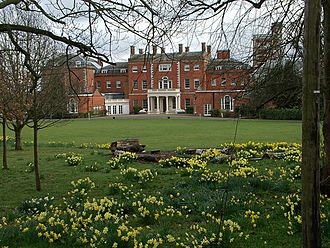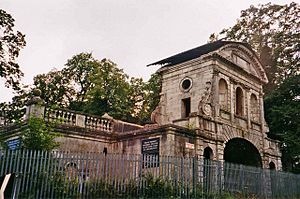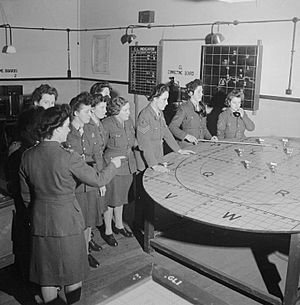Theobalds House facts for kids
Quick facts for kids Theobalds House |
|
|---|---|

Theobalds Park (now Birch) Hotel
|
|
| General information | |
| Coordinates | 51°41′20″N 0°3′22″W / 51.68889°N 0.05611°W |
Theobalds House (also known as Theobalds Palace) was a very important and grand house in Cheshunt, Hertfordshire, England. It was located north of London.
In the 1500s and early 1600s, it was a home for powerful government advisors like William Cecil, 1st Baron Burghley and his son. Later, King James I loved staying there so much that he bought it. He made the house and its large park even bigger. Theobalds House was a great example of a "prodigy house," which was a huge, fancy country home built by rich people to show off their wealth and power. Sadly, it was torn down during the English Civil War.
Much later, in 1763, a new mansion called The Cedars was built nearby. This house and park were bought and made even bigger by the rich Meux family, who were famous brewers. A famous old gate from London, called Temple Bar, was moved to the park in 1880. It stayed there until 2003 when it was moved back to London. The mansion has been many things, including a school and a college. Today, it is part of a hotel and club called Birch. The house is a special historic building, listed as Grade II* listed.
Contents
The First Theobalds House
The land where Theobalds House stood was once called Cullynges. Over time, its name changed several times before becoming Theobalds. The very first house on the property had a moat around it.
In 1563, William Cecil, 1st Baron Burghley, who was a top advisor to Queen Elizabeth I, bought the estate. He often invited Queen Elizabeth to stay at his home.
Building a Royal Home
Lord Burghley wanted a magnificent new house, so he had one built between 1564 and 1585. He wanted the mansion to show how important he was at the Royal Court. He also wanted it to be grand enough for the Queen to visit comfortably.
Queen Elizabeth I visited Theobalds eight times between 1572 and 1596. The house was in a perfect spot, just off the main road from London. It was about a 2.5-hour horse ride from London, making it a great place for the Queen to stop on her royal tours.
The beautiful gardens at Theobalds were designed to look like the famous Château de Fontainebleau in France. An English plant expert named John Gerard helped manage them. The house had many amazing features, including a large staircase with detailed oak carvings. There was also a special water feature and a ceiling decorated with the signs of the zodiac.
Inside the Great Hall
When visitors arrived, they would first enter the Great Hall. This room was two stories high and had oak walls. It also had a special balcony for musicians. The ceiling was arched with fancy wooden designs. The fireplace was made of blue marble. In 1585, a painter added the coats of arms of England's noble families to the walls.
The Green Gallery
Another impressive room was the Painted, or Green Gallery, finished in 1574. This long room was decorated with maps and family symbols. Visitors from other countries, like Germany, described it. One visitor in 1602 said that England was shown by 52 "trees," with each tree representing a region and displaying the symbols of its noble families. There were also items showing what each region produced.
In 1597, some thieves broke into the Queen's private rooms and stole silver items. They were caught, and the silver was returned. Lord Burghley's son, Robert Cecil, 1st Earl of Salisbury, later inherited the house.
King James and Theobalds
After Queen Elizabeth died in 1603, Robert Cecil made sure the new king, King James I, stayed at Theobalds on his way from Scotland to London. King James loved the house so much that in 1607, he traded his own Hatfield Palace for Theobalds.
King James gave Theobalds to his wife, Anne of Denmark, in 1607. This was celebrated with big parties, hunting, and tournaments. Theobalds quickly became King James's favorite country home. He ordered many improvements to the house and grounds.
The King enjoyed hunting in the nearby Waltham Forest. In 1613, Queen Anne was hunting deer at Theobalds and accidentally shot the King's dog with a crossbow. In 1622, King James fell into the New River while riding from Theobalds to see the ice. Luckily, he was rescued and returned to a warm bed at the house.
King James died at Theobalds on March 27, 1625. After his death, his son King Charles I became king. Later, after King Charles I was executed, Theobalds House was mostly torn down by the new government in 1650.
The New House: 1700s and 1800s
In 1762, the land was sold to George Prescott, a merchant. Prescott built a new house in the Georgian style called The Cedars. It was about a mile west of where the old palace stood.
Around 1820, the Meux family, famous for their brewery, bought the new house. They made many changes and additions in the 1800s. They even added a new entrance that looked like Sir Christopher Wren's Temple Bar from London.
Temple Bar at Theobalds

In 1888, the beautiful and unique Lady Meux bought the old Temple Bar gate from the City of London. The gate had been taken apart and stored. She had the 400 tons of stone moved by horse-drawn carts to Theobalds Park. It was carefully rebuilt there for £10,000. Lady Meux often entertained guests in the upper room of the gateway, including King Edward VII and Winston Churchill.
Recent History
When Sir Hedworth Lambton, a naval commander, returned to England, he visited Lady Meux at Theobalds. She was so impressed by him that she made him the main person to inherit her wealth. She had one condition: he had to change his last name to Meux. When she died in 1910, he agreed and inherited the estate and a share in the Meux Brewery.
In 1921, part of the park, where the old Elizabethan mansion used to be, was given to the town of Cheshunt. It became a public park called The Cedars. After Sir Hedworth died in 1929, the house was a hotel for some years.
During World War II, the house was used by the military and then by the police as a riding school. In 1955, it became a secondary school, and later, an adult education center. In the 1990s, it was updated to be a conference center. Today, it is known as Theobalds Park Hotel.
Temple Bar Returns to London
The Temple Bar gate stayed with the Meux family's estate. Even though it was a protected historic monument, it started to fall apart. After a long effort, it was decided to move it back to London in 2001. The arch was taken apart again and rebuilt next to St Paul's Cathedral. This project was finished in November 2004, and a special plaque was placed in Theobalds Park to remember its time there.




